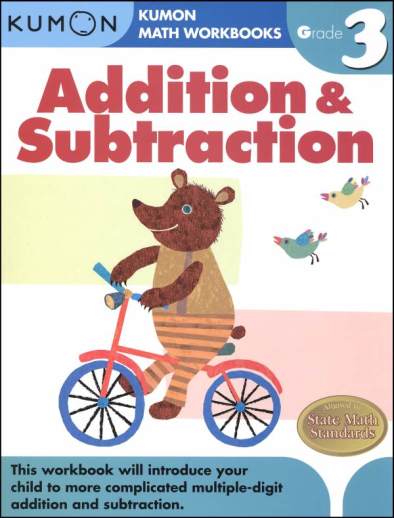We use cookies to make your experience better. To comply with the new e-Privacy directive, we need to ask for your consent to set the cookies. Learn more.
Addition & Subtraction Grade 3 Workbook
Math problems with large numbers can be overwhelming. Through our step-by-step progression of activities, your child will easily master addition and subtraction with four-digit numbers. Our workbook builds on basic addition and subtraction skills to teach your child how to confidently compute addition and subtraction with large numbers.
Topics Covered in this Book:
A math program based on the Kumon method. Basically, the earmarks of this system are:
- Concepts introduced in small, incremental steps, allowing children to master them without confusion
- Single topic books rather than mixed strands. Children concentrate just on addition, for example, before moving to subtraction
- Concepts are taught by discovery method than being spelled out
The series is meant to be self-directed. Students take charge of their own learning on every level. They complete pages, check their work, record their scores, and determine whether to move on or review. The pace almost guarantees success. Children should work a "few" pages a day; assignments should take about 20 minutes to complete. Pages are marked with the skill level required at top and the points each question is valued at (a very young child will need some help totaling points). Very short instruction (or an example) is given on a few pages. For example, there is a short explanation when children begin to subtract a 2-digit number from a 3-digit number where borrowing is needed. However, the child is given every opportunity to intuit this beforehand. By the time he reaches this page, he has already been subtracting double-digit numbers for many pages. Some of these would require borrowing, but, since they are able to subtract, say, 7 from 12, the Kumon method wants the child to see a pattern when increasing to 7 from 22, 7 from 32, etc. This does remind me of the approach used in Miquon as well. Besides these very infrequent helps there are just some small prompts for children to look for patterns in their answers, and words of encouragement. Pages are pleasing to the eye; they are colored, clean, and problems are well-spaced. The Kumon method has been used successfully with children around the world for over 50 years. It does seem like it would help a child to take charge of his own learning and help himself to understanding rather than being spoon-fed each bite. For Kumon math earlier than Grade 1, see the Kumon section in Early Learning.
| Product Format: | Softcover Book |
|---|---|
| Brand: | Kumon Publishers |
| Grade: | 3 |
| ISBN: | 9781933241531 |
| Length in Inches: | 11 |
| Width in Inches: | 8.5 |
| Height in Inches: | 0.25 |
| Weight in Pounds: | 0.78 |

